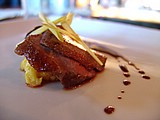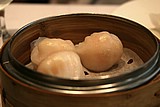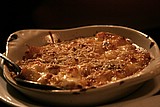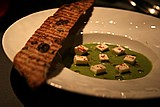Home |
Restaurants by City
|
Food Photography |
Archive | Philosophy |
![]()
Right now we are eating in Seattle, Washington.
|
Thursday
2005
Permalink
|
The Inn at Langley, Whidbey Island, Wa, tasted on June 26, 2004 — I grew up in Boston. And in Boston we had the Cape. Cape Cod to be specific. But my home is now Seattle, and we have our own coastal getaways - the Islands. And there are quite a few of them. Honestly my expectations of the best food on Cape Cod are mostly around the lobster rolls you can get from various roadside stands. Even Martha's Vineyard and Nantucket don't necessarily get me excited in terms of what restaurant food is available, though there are certainly some farm stands that are fantastic. I guess my expectations of the kind of food out in the islands off Seattle are really not that different. Some nice fresh produce in season, some local specialties, and that's good enough for me. But, last summer we stayed at the Inn at Langley, a super nice, Pacific Northwest archetypal inn. And somehow they managed to grab an accomplished Seattle chef - Matt Costello - to move out to the island, and cook in their restaurant. And while we were out there, I could understand the attraction. A small restaurant, sources for local ingredients, seasonal work, a beautiful locale, and operating at a scale that lets the chef really control many more variables than they might in a city restaurant. This could be interesting. We started off checking out the wine list. At first we were put off that there weren't any wines by the glass. When there's only two of us we simply can't finish most of a bottle of wine. (For anyone confused by this it's mostly my fault as I fall asleep by the end of the second glass.) But then I noticed that they had a decent selection of half bottles. And the logic of this became evident. I'd rather have the wine fresh out of a newly opened bottle, than have a glass from last night's half-finished bottle. Cool. We got the NV Henriot Champagne Brut that was recommended by the chef. Frankly, we loved it. The bubbles were fine, and the flavor super creamy. It had the aroma of butter. On that night it felt like a 96 point Champagne to me. As we savored our champagne, Chef Costello spent some time addressing the diners who were all going to be eating the same tasting menu on the same schedule. One seating, one menu, simple simple simple. He talked to us for awhile about Whidbey Island terroir. OK. I admit it, I hadn't thought about Whidbey Island as really being a source for various unique ingredients or particular types of items that can make a dish stand out. But in truth, I really know crap about where I live, and Washington state is actually quite agricultural. And apparently, the chef had spent quite some time scouring the island and getting to know the local farmers and producers. So I figured, as long as the quality of the food supported the promises of the narrative then we'd be in good shape. And we were. First up was the amuse - Cardamom Squab on Balsamic Cherries and Sweet Corn with Fresh Corn Shoots. This was simply excellent. Sizable slices of squab with both the sweet tones of the cherries and sweet flavors of the corn each having their own unique space but but still complementary. The squab was juicy and savory and the corn shoots were new to me. The corn itself as the base flavor was foundational to the dish and really made it whole. Debbie pointed out that every every element in the amuse had some hits in the sweetness spectrum but there were many other flavors present as well. Next up was Fresh Shell Pea Soup with Lemon Crème Fraiche and Penn Cove Mussels. This pea soup was different than any other I've ever had. It had a light texture (and some hints of the flavor) of of avoglemono (no doubt due to the lemon crème fraiche. While mussels have never been my favorite they are indeed growing on me, and these in particular added a light savory component to the dish and they were not overly chewy. Some yummy bread came out at this point. It was served hot and there was a variety. Debbie approved wholeheartedly of the fact that the butter was not served ice cold. She prefers it to sit out and get a little softer before it arrives at the table. And just to prove that you can't please everyone, I actually don't like it too soft. In fact, especially with hot rolls, I like the butter kind of cold so I can get the temperature contrasts in my mouth. Apparently our palates were due for some calming as a Trio of Gazpacho Inspired Sorbets showed up next. I wondered if they would be more "shticky" than yummy but in fact they were cleansing, refreshing, and simple. The cucumber was subtle while the saffron surprisingly, strong and good. My favorite was the tomato as it had an incredibly deep, fresh, and almost citrusy tomato goodness. Excellent! We munched some more on the bread and had some of the best potato bread ever. It was subtle but flavorful - and had just the right amount of salt. We had a pair of entrees. The Seared Black Cod on Crushed New Potatoes with Wild Morels and Tomatoes and the Muscovy Duck Breast with Plum-Foie Gras Tart Tatin and Dandelion Greens. The cod was light, buttery in flavor and texture, and had a crispy outside. Yummy. The duck was very very good. I wished for it to be cooked slightly rarer, but Debbie thought it was perfect. This is one of those judgment calls. And often I wonder if chefs make certain decisions as they know the bulk of their customers would send back duck that they considered underdone (even though in my opinion it would be perfect). But I shouldn't assume as I don't really know. And after all, Debbie is not exactly an inexperienced diner and she likes her meat on the rare side, and she thought the duck was just right. The dish also had surprising tart flavors which added a ton to the salty/savory duck crust. Again we noticed that Costello used sweet flavors well. I'm not usually a fan of a lot of sweetness but in these dishes it was neither syrupy nor cloying. Debbie also thought the spinach was very well prepared. I agree as it retained those essential fresh spinach tones. The entrees were too big for my taste, but then again they always are. I'm just a small plate guy. I get tired of a dish when there's too much. And if I had one other nit to offer it would be that the duck dish advertised foie gras but I couldn't find any. I have no doubt it was there, I just wonder if it's wrong of me to feel that foie gras in particular shouldn't be mentioned in the name of a dish if it's not really featured in a way I will notice. This may be short-sighted thinking on my part, or just testament to my deep and abiding love for foie gras. The cheese course was surprisingly good. It was Delice De Bourgogne cheese with Candied Baby Beets, Bronze Fennel and Orange. I knew this cheese well and have eaten it many times. The beets, fennel, and orange formed an excellent combination. There's something about finding three flavors that go well together that has a sort of natural harmony and just strongly resonates with me when it's done really well. Maybe it's the odd number of ingredients, or the different combinations that can happen in your mouth. Whatever it is, when a chef balances three flavors really well (no more, no less) I find myself particularly moved. Debbie thought the beets were the perfect complement to the cheese. And I couldn't help but notice that it was really more than a cheese course. I liked that the cheese shared the stage with other items. Sometimes a cheese course can be overwhelming and this was really an enjoyable dish. Things finished up with a lovely Washington Cherry Sorbet with Cherry-Almond Strudel and White Chocolate. I have always thought that scale is the enemy of quality. The best chefs can make excellent food consistently for a reasonable number of diners each night. Unfortunately many of them try to scale beyond even that opening multiple restaurants and putting their name on frozen food. This is the point at which I usually wonder why the hell I'm eating their food. It's not that I'm offended by someone trying to build a business. Believe me, I'm not. It's that almost always the expansion comes at the cost of the qualities that made the chef (and now the brand) special. At one point in the meal that I couldn't help but notice that the pacing was really great. This was all the more impressive as Costello appeared to be doing 98% of the cooking all by himself. His staff was doing some of the plating, but he was basically single-handedly feeding 22 people (I counted) in the restaurant all eating at once. Now there are ways to make this possible. All 22 people were eating the same menu. And the menu was no doubt designed so as much as possible could be made in advance. His staff also clearly were playing key support roles not only serving but doing some of the plating as well. Now while I don't know what was on Chef Costello's mind when he decided to leave being a chef in Seattle for essentially a part-time gig out on the island, I can't help but think he carefully scaled down his efforts so that he could exert even more control on the food he creates and serves to customers. And ultimately this seems like quite the opposite of what most chefs are doing, and unsurprisingly has the opposite effect. By scaling down his efforts, he can focus even more on every detail of the food we were eating. And it showed in the attention to detail, and the consistency of the vision throughout the meal. I know the words simple, fresh, and seasonal are overused to the point of being meaningless, but they really did ring true for this meal. I'm excited to go back.
|
|||
Our Sponsors
Free Car Listings – Hot Tubs – Stools – Saunas – Bar Stools - Calendar and Event Schedules - Food Events and Calendars - Wine Events and Calendars - Digital Photography Resources - Software for Advertisers - Jewish Gifts and Judaica - Howard Stern Podcast - ponytailed blogger Jonathan Schwartz

Browse tastingmenu
Home |
Restaurants by City X |
Food Photography |
Archive | Philosophy |
![]()
Free eBooks: All About Apples
| Autumn Omakase
More:
Discussion |
Cool Food T-Shirts |
Ingredients
| Markets |
Recipes
Search |
Blog FAQ |
Other
Blogs
Best of tastingmenu
|
City View
Entry: July 6, 2006 |
Blue Plate
Entry: June 19, 2006 |
L'Atelier de Joël Robuchon
Entry: July 18, 2006 |
Browse by City
Boston | Chicago | Houston | Las Vegas | Los Angeles | Maui | New York | Philadelphia | Portland | San Francisco | Seattle | Toronto | Utah | Vancouver | Washington D.C.
Bangkok | Beijing | Hong Kong | Seoul | Tokyo
Amsterdam | Berlin | Italy | London | Madrid | Paris | Vienna
Browse by Month
2006
2005
2004
2003
2002
2001
Comments, questions, or feedback:
info / at / tastingmenu / dot / com
All pages Copyright (c) 2001-2006 tastingmenu.com
Last modified 01/30/07.




